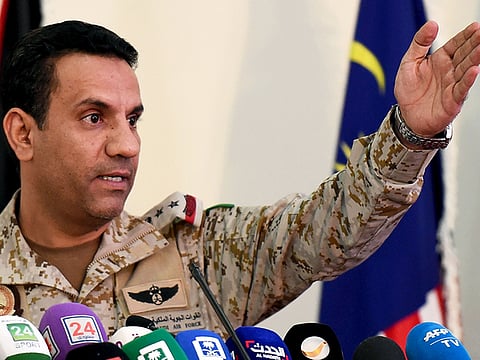Terrorist Al Houthi militia hijacks UAE-flagged cargo ship
Vessel, carrying medical field equipment, was on maritime mission to Jazan Port

Riyadh: The terrorist Al Houthi militia late on Sunday hijacked a UAE-flagged cargo ship off the coast of Al Hudaida Governorate, Brigadier General Turki Al Malki, official spokesperson of the Coalition to Restore Legitimacy in Yemen, announced yesterday.
“At (23:57) on Sunday (2nd January 2022), the Cargo Ship (RWABEE) sailing under the flag of the United Arab Emirates was targeted through ‘piracy and hijacking’ while sailing off the coast of Al Hudaida Governorate,” the spokesperson was quoted by Saudi Press Agency (SPA) as saying.
The ship was conducting a maritime mission from the Island of Socotra to Jazan Port. It was carrying medical field equipment, that were used to operate the Saudi Field Hospital on the Island. The field hospital has concluded its mission following the establishment of a hospital on the Island.
Al Malki added that the ship’s field hospital equipment cargo includes ambulances, medical equipment, communication devices, tents, a field kitchen, field laundry units and technical and security support equipment.
“This act of Piracy by the terrorist Houthi militia is a credible threat that highlights the danger of the terrorist Houthi militia on the freedom of navigation and international trade in the South Red Sea and Bab Al Mandab Strait.
“The terrorist Houthi militia will bear full responsibility as a result of its criminal act of Piracy against the ship, which violates the customary International Humanitarian Law, the San Remo Manual on Armed Conflicts at Sea and the United Nations Convention on the Law of the Sea (UNCLOS).
“The militia must promptly release the ship, or the Coalition Forces will undertake all necessary measures and procedures to handle this violation, including the use of force if necessary,” the spokesperson said.
Here are some details about Al Houthis, also known as Ansar Allah.
HISTORY In the late 1990s, the Houthi family in far north Yemen set up a religious revival movement for the Zaydi sect of Shiites, which had once ruled Yemen but whose northern heartland had became impoverished and marginalised. As friction with the government grew, they fought a series of guerrilla wars with the national army and a brief border conflict with Saudi Arabia. LINKS WITH IRAN They built ties with Iran, but it is not clear how deep that relationship goes. The Saudi-led coalition accuses Iran of arming and training the Houthis, a charge both deny. The coalition also says Lebanon’s Iran-backed Hezbollah is helping the Houthis, an accusation it rejects. While Iran champions the Houthis as part of its regional “axis of resistance”, Yemen experts say they are motivated primarily by a domestic agenda though they share a political affinity for Iran and Hezbollah. The Houthis deny being puppets of Iran and say they are fighting a corrupt system. WAR The Houthis joined a wider national uprising in 2011 against the rule of Ali Abdullah Saleh, who was persuaded by Gulf states to step down. The group later partnered with their erstwhile foe to seize the capital Sana’a in 2014 and oust the Saudi-backed government. Saleh was killed by the group in 2017 when he switched sides. After the Saudi-led coalition intervened in 2015, the Houthis and Saleh’s forces were driven from Aden and its environs in south Yemen, and from central Marib. Years of military stalemate have followed, with the Houthis maintaining their hold on Sana’a and most big urban centres. CAPABILITIES Despite years of coalition air strikes against them, the Houthis continue to launch drones and missiles towards Saudi cities. The Houthis, who took over swathes of Yemen’s conventional military, say they are manufactured domestically. UN investigators said in a report this year that the Houthis receive military support in the form of arms and that some of those weapons have technical characteristics similar to arms manufactured in Iran. The Houthis have hundreds of thousands of fighters under their control.
Sign up for the Daily Briefing
Get the latest news and updates straight to your inbox



